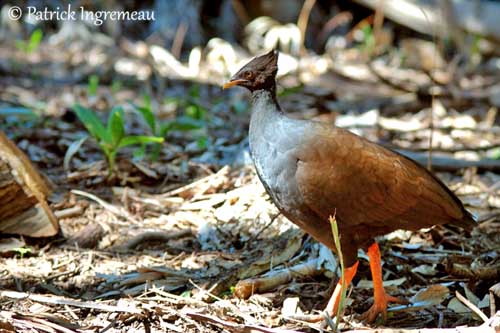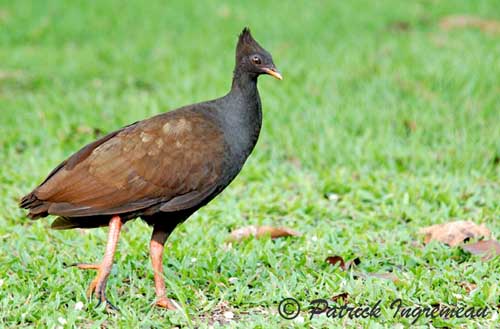
Orange-footed Scrubfowl
Megapodius reinwardt
Galliforme Order - Megapodiidae Family
BIOMETRICS:
Length: 35-47 cm; Weight: M : 850-1200 g – F : 560-1200 g
DESCRIPTION:
Orange-footed Scrubfowl is one of the three Australian megapodes. Their drab plumage with combination of brown, black and grey is well adapted to their terrestrial life.
Adult male has grey upperparts, widely tinged with chestnut. Wings and short tail are dark chestnut.
On the underparts, throat, breast and belly are dark grey. Lower belly and vent are tinged with chestnut.
On the head, we can see a pointed chestnut-grey crest. Head is dark grey, as neck, upper back and shoulders.
Pointed, strong bill is yellow. Eyes are brown, surrounded by grey bare skin, extending to lores and upper base of bill.
Robust legs and feet are orange, or pinkish-red. Feet show long, sharp, black claws.
Both sexes are similar, with female slightly smaller.
Juvenile resembles adults, but it is smaller, with duller head.
VOICE: SOUNDS BY XENO-CANTO
Orange-footed Scrubfowl utters some gargles, and also loud crows repeated twice. It can be heard at night.
It is usually less noisy than other scrubfowls. But they can give advertising calls at territory boundaries. Territorial calls can be heard up to 6 km in good conditions, mainly at night. Male and female can perform duets, uttered from perches, mainly during breeding season, but also year round.
HABITAT:
Orange-footed Scrubfowl lives mainly in forests and wooded areas, rainforests and swamp forests. It is mainly seen in lowlands, but in some parts of its range, it can be seen up to 1500-1900 metres of elevation.
It breeds in clearings, near forest edges, and sometimes on small islands.
RANGE:
Orange-footed Scrubfowl is found on islands in Wallacea, in southern New Guinea and northern Australia.
BEHAVIOUR:
Orange-footed Scrubfowl is a terrestrial species, feeding on the ground. The bird digs for searching food in the earth, by scratching on the ground with its powerful feet. It feeds on seeds, fallen fruits and invertebrates. It forages on the ground, walking along, scratching in leaf litter, and examining the ground with great attention. It leaves several piles of turned leaves behind it.
It is particularly nocturnal in its activities.
FLIGHT:
Orange-footed Scrubfowl is mainly terrestrial, but it can take off if threatened, in order to escape predators. However, it is not able to fly long distances.
REPRODUCTION:
Orange-footed Scrubfowl, as some other megapodes, uses unique incubation system.
Both sexes build a mound with leaves, earth, sticks, debris, sand…circular or elongated. This mound is usually built on flat or slightly sloping ground, in shade.
This mound can be used separately by different pairs, and it is reused year after year.
Birds don’t incubate. Eggs are incubated by the heat produced by the decomposition of materials. Maintenance of the mound takes place throughout the year. It can become very large, up to 3 to 4 metres of height and 9 to 13 metres in diameter or length. It can weight several tonnes.
Female can lay 12 to 13 eggs, with long intervals of 9 to 20 days, and during long period of 20 weeks. Incubation period in unknown, but eggs are laid when the temperature of the mound reaches about 30 to 35 degrees. This period can lasts from 50 to 100 days.
The chick uses its egg tooth for breaking the egg shell. It is strongly precocial and very large. It has to struggle up to the surface of the mound, and needs for that from some hours to a journey. It does not receive any parental care. It is able to fly short distances in its first day of life, and can begin to feed alone. It is fully feathered and able to regulate its own temperature.
Predators such as monitor lizards, dingos and foxes are major cause of the low hatching success.
Fr: Mégapode de Reinwardt
All : Reinwardt-Huhn
Esp : Telégala de Reinwardt
Ital : Megapodio zampearancio
Nd : Rood Boshoen
Photographs by Patrick Ingremeau
TAMANDUA
Text by Nicole Bouglouan
Sources:
HANDBOOK OF THE BIRDS OF THE WORLD Vol 2 by Josep del Hoyo-Andrew Elliot-Jordi Sargatal - Lynx Edicions - ISBN: 8487334156
Wikipedia (Wikipedia, The Free Encyclopedia)

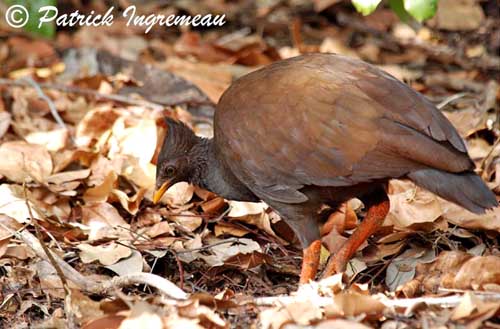
Orange-footed Scrubfowl, as other megapodes, is very well adapted to the terrestrial life, and these birds spend most of their time on the ground. This species is often seen in pairs, holding and defending territories where incubation mound can be found, but not necessarily. An incubating mound can be used by female coming from other territory, but if food resources are abundant, two pairs can share the same mound.
When Orange-footed Scrubfowl is threatened or alarmed, it bobs its head up and down. Sometimes it leaves it motionless, and it attempts to locate the danger. It can react to potential danger by flying up into close trees. Its relatively small body-size allows it to take off for safe. Its powerful claws easily grasp the branch.
This species is known for having communal roosts in trees.
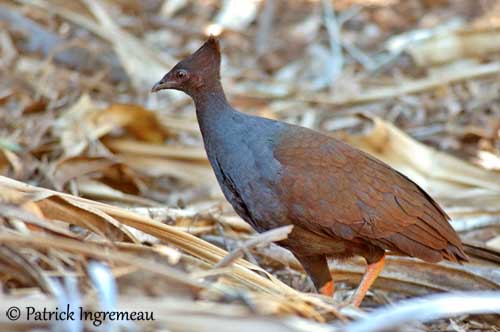
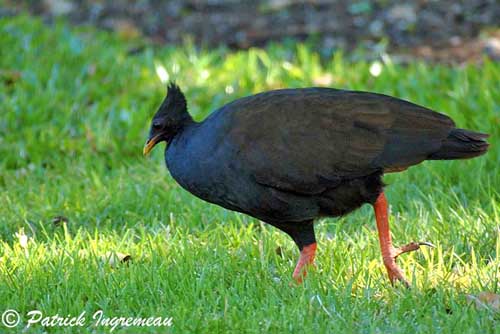
DIET:
Orange-footed Scrubfowl feeds mainly on seeds, fallen fruits, berries, roots and shoots of flowers. It also consumes snails, earthworms, insects and their larvae. Food is found in leaf litter.
PROTECTION / THREATS STATUS:
Orange-footed Scrub fowl’s populations are not globally threatened. In some parts of the range, this species can be threatened by human developments, exploitation for food, degradation of the habitat and introduced predators.
However, populations remain stable, and these birds are common and widespread in some parts of the range.
